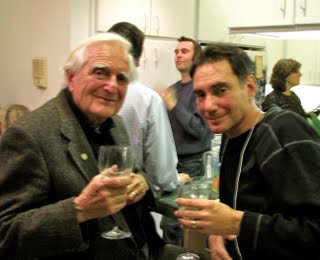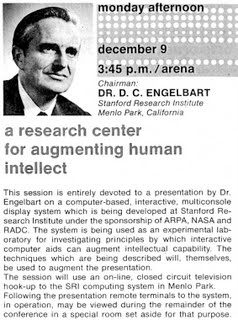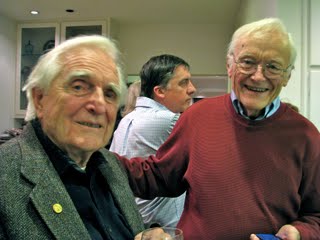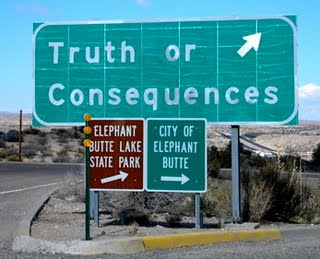 |
| Doug Engelbart and David Nordfors |
On December 9, world leaders debated global climate in Copenhagen and Obama was in Oslo to accept his Nobel. I was sharing a glass of wine with Doug Engelbart, father of personal computing as we know it, in the kitchen of Mei Lin Fung, Doug's long-time friend, in Palo Alto. It was a potluck dinner, shoes off, sparing Mei Lin's floors. I sensed links. Half a world away, people were commemorating the world's biggest problems, preparing for gala dinners, while we toasted the birth of perhaps the most powerful tool in human hands, sitting in that cozy kitchen among people who had made it happen.
Doug was guest of honor. In San Francisco, on Dec 9 1968, his 'Mother of All Demos' gave birth to the modern PC: Doug and his SRI team, with chief engineer Bill English, demo'ed for the first time personal computing as we recognize it today, showing the first computer mouse, interactive text, video conferencing, teleconferencing, email, hypertext and a collaborative real-time editor.
 |
| Mei Lin Fung |
When groups face common problems, power goes to those who must agree for anything to happen. Often their political power and the value of their 'OK' grows as they hold out--supply and demand. If the problem is bad and people want their 'OK' they say 'Well, first YOU must [insert demads here].' They may be conscientious, backed by their constituencies, so it might not seem immoral. Leaders build power, stature and wealth for their followers by gatekeeping. Some may get a Nobel, others may end up in the International Criminal Court in the Hague. The need for consensus breeds gatekeeping. That's the game.

Back to Mei Lin's kitchen. It might be closer to the solution than banquet halls in world capitals. The name 'Mother of All Demos' came later. The actual name marking the birth of real personal computing was 'a research center for augmenting human intellect.' Doug's idea was not to make computers smarter, it was to help people be smarter. Computers had been about automation, replacing but not augmenting intellect. Doug was lucky, a chosen researcher supported by J.C.R. 'Lick' Licklider at ARPA, the visionary accredited for planting the seeds of computing in the digital age. Normal funders disdained people like Doug: the ideas did not fit their funding.
Lick coined the "intergalactic computer network," a vision of computers collaborating. The Internet protocol that enabled it was invented by Vint Cerf and Bob Kahn. Vint - often referred to as 'father of the Internet' - is today at Google, still reforming civilization.
Doug hosted the second node of the Arpanet, the predecessor of the Internet, at his SRI center, believing that by networking PCs humanity could improve its 'collective intelligence' and solve tougher problems: such as avoid nuclear wars, stop pandemics and solve environmental issues. Solutions via traditional multilateral agreements may be hard: they engender gatekeeping, brinkmanship and cheating on agreements.
But through improved PCs and the Internet, it is easier to innovate, to introduce game-changing novelties, that can bypass obstacles to getting things done. If gatekeepers disagree, innovate and re-design the game to work without them.
 |
| Doug Engelbart and Bill English Bill is holding the Google Phone |
Voices--including Thomas Friedman's--are saying that innovation, not multilateral regulation, should drive the climate issue. The ideal: a balance between innovation and regulation. Necessary international agreements can be driven by the innovation ecosystem, putting gatekeepers at risk of being bypassed. And international agreements can enable the innovation ecosystem, through creating incentives.
 |
| David Nordfors |
PS. The achievement of 'the Mother of All Demos' was astonishing. Mei Lin: "That demo was never supposed to work." It might not have if not for Bill English. Bill was there, showing his new cell phone. Later it became known that Google had given beta versions of its own Android to selected people (Bill probably among them). Did anyone in Oslo or Copenhagen get one?


















